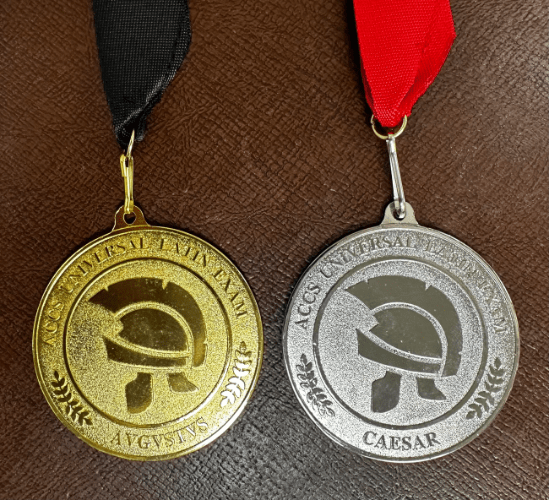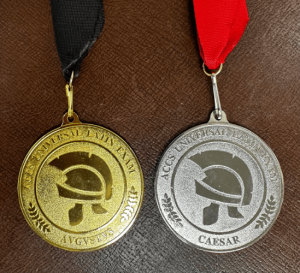Universal Latin Exam (ULE)
Registration Deadline: February 28, 2025
MM
XX
IV
2025 Test
![]()
ULE Overview
![]()
Methods
![]()
How It Works
![]()
Scoring
Last year, over 4500 students from 78 schools took the exam. Your school could be one of them!
Thank you for the opportunity you are giving our students to participate in something that can provide a sense of accomplishment and satisfaction after all of their hard work studying Latin! – ACCS member in Medford, NJ, 2023
We passed out awards to great fanfare, some surprised faces, and a few tears! – ACCS member in Fort Worth, TX, 2024

2024-
2025 School Year
Important Dates & Notes
Exam Schedule
Registration Deadline* | February 28
Exam Customization Window | January 1 – February 28
Payment Deadline | March 10
Exam Period | March 17 – 28
Exam Postmark Deadline | March 28
Results Sent | May 9
*Early Registration Special: Register by December 20 and save $10 off the school fee!
Exam Cost
The Universal Latin Exam fees are as follows:
$55 per school ($45 early registration) + $4.75 per student
The Process at a Glance
Click here to see more detail.
- The administrator purchases exams for participating classes or groups.
- A head Latin teacher customizes the content for each exam, so students are only tested on material they have studied.
- Teachers download custom study guides which include all the concepts and vocabulary for their exams.
- The school receives exam PDFs five days before test day and administers paper exams within a two-week window in March.
- The school assembles the tests by class, scans them into a PDF, and uploads them to our office. Paper tests are sent in the mail to ensure we have the physical copies in case something goes wrong electronically.
- Schools receive awards in time for end-of-the-year assemblies as well as results to help them understand their students’ performance.

What is the ULE?
The Universal Latin Exam is a new, versatile standardized test for schools who know the importance of tracking their students’ progress, while ensuring that their Latin program is comparable with other schools.
Unlike other tests, the Universal Latin Exam does not bias one curriculum or methodology over another. It tests students’ knowledge of the mechanics of the language itself — how accurately students understand short sentences written in Latin.
This is usually difficult because students learn grammatical concepts in varying orders, but our test is customized for each classroom. Students only see questions on concepts they have learned. This means students and schools can be accurately compared based on how much and how well students know Latin.
Designed and written by the ACCS’ Institute for Classical Languages, our approach ensures customized, Christian-friendly content for all classes.
Who should take the ULE? Anyone in the process of learning Latin! From 3rd grade through high school.
Why? To compare and evaluate
When? To be administered in March
How much? $55 per school ($45 early registration) + $4.75 per student
Have Questions? Contact [email protected]
Methods
The ULE uses very simple questions for which students must rely completely on their understanding of grammatical forms and their meaning. For example, common sense and word order alone are not sufficient to answer a question like the following. Only students with an understanding of the accusative and dative cases will be able to determine the correct answer.
1.) Aquam lūtrae dat.
A) He gives the otter to the water. B) He gives water to the otter. C) He gives the otters to the water. D) The otter gives water.
Some questions require students to choose the Latin word that correctly communicates a specific meaning. These questions require a very precise understanding of Latin mechanics. In the following example, in order to answer the question, students must understand how both adjective matching and declensions work.
2.) The owner gives the dog a nasty shoe.
A) calceum turpium B) calceum turpem C) calceum turpis D) calceum turpī
More advanced students will encounter questions for which an understanding of Latin syntax is necessary. To answer the following question, the student must understand that C and D are not permitted by Latin syntax, and that B is permitted but would be absurd.
3.) Pastor ____ arborēs videt.
A) ambulāns B) ambulāre C) ambulat D) ambulā
The number of questions on a test correlates to the number of concepts being tested. Older and more advanced students will generally receive more questions (up to a maximum of forty), while younger students will generally receive fewer (though not less than ten). A small number of questions on a test may seem counterintuitive. However, because of the very specific nature of the ULE, which is to test knowledge of the mechanics of the language itself by how accurately short sentences written in Latin are understood, a few well-constructed questions reveal much. Even with a relatively short exam, our internal data indicates a good correlation between ULE score and true Latin grammar proficiency.
How it works
1. Purchase & Customize: Schools purchase the correct number of tests online. The head Latin teacher receives a link to customize the tests.
- He or she will need to have class rosters with the full name of each participating student, and will need to know how far students will have gotten by the test date.
- Using our web app, the teacher selects curricula, books, and chapters, then has the option to click or unclick each grammar concept box to account for skipped chapters or added lessons.
- If we don’t have your curriculum in our database yet, or you use your own, you will be able to self-select all your concepts.
- Our program customizes your test using the concepts that your students know.
2. Download the Study Guide: The teacher will receive access to a downloadable study guide in the app. This study guide will remind them what concepts they should review and what vocabulary students need to know.
3. Print and Take the Test: A PDF of each student’s test will be sent to a school administrator who prints them and delivers them to the classroom on the day of the test. The exam should generally be administered within the length of a normal class period for the class. Younger students will naturally have far fewer questions to answer, so they may not even need all of this time. Older students may need an entire class period to complete their exams. Schools are permitted to extend a class period to one hour for older students; however, under no circumstances may a student have more than one hour to complete the exam. As you plan your exam schedule, make sure to allot several minutes for reading the exam instructions to students and answering any questions.
4. Upload and Mail Completed Tests: Once students have taken the test, the teacher collects them, and the test administrator scans the tests by class to PDF and uploads them to our office. Paper tests are sent in the mail, clearly separated by class, to ensure we have the physical copies in case something goes wrong electronically. Tests are mailed to:
Universal Latin Exam
Institute for Classical Languages
P.O. Box 9741
Moscow, ID 83843
5. Get the Results: Results will be sent out by early May! Schools receive awards in time for end-of-the-year assemblies as well as results to help them understand their students’ performance.
Note On Curriculum
Note: If your school uses curriculum listed below, the customization process will be automatic. If not, you will just need to take a little extra time to select concepts for yourself. We’re working on entering more curricula.
Latin Alive or Latin for Children (Classical Academic Press)
Wheelock’s Latin (Collins Reference)
Form One or Latina Christiana (Memoria Press)
Lingua Latina per se Illustrata: Familia Romana (Focus Publishing)
Cambridge Latin Course (Cambridge University Press)
Latin Primer or Latin Grammar (Picta Dicta)
Updated 11/1/24
Would you like to suggest future curriculum to be included? Contact us!
Scoring
If each test is different, how do you compare yourself with other schools?
Students are compared by their percentile ranking within their grade group. When we grade a student’s test, we compare his score with the scores of all other students from the same grade who took the exam. Students who place in the top percentiles nationally within their grade level will receive awards.
ULE Awards
 The ULE bestows two honors upon top-ranking students: the silver CAESAR award and the gold AVGVSTVS award. Both come with a certificate and a medal, and schools are encouraged to present students with their awards at an end-of-year assembly.
The ULE bestows two honors upon top-ranking students: the silver CAESAR award and the gold AVGVSTVS award. Both come with a certificate and a medal, and schools are encouraged to present students with their awards at an end-of-year assembly.Our goal is to provide a helpful tool for mapping how much progress students are making over time and where they are compared to national trends. Therefore, as we assign awards, a student’s score is determined by how many concepts he proves his knowledge of, not just the percent of the questions on his exam that he gets correct.
Thus, this test helps compare schools and students across the country; Latin teachers can see how proficient their 5th graders are compared to 5th graders at many other schools around the nation. Accordingly, our approach is similar to what you would see in other competitive programs, both academic and athletic: students compete against other students of like age. We believe that this strategy ensures a meaningful and helpful measure.
However, we do recognize that students who have started Latin later in their school career—and so are less proficient than others in the same grade at other schools—may not receive awards as readily, even if they do well on the exam and would merit honor at a school’s award assembly. So, even though these students may not rank as high on the national percentiles, we recommend that schools recognize such students with an in-school commendation based on their score within their class.
Please note: Because we configure exams for students depending on how many concepts they know, higher-level students will be given longer tests than beginning-level students.
